Detecting and Mapping Gas Emission Craters on the Yamal and Gydan Peninsulas, Western Siberia
Abstract
1. Introduction
2. Materials and Methods
2.1. Study Area
2.2. Multivariate Change Detection Algorithm for Detecting and Mapping Land Surface Change
2.2.1. Change in Surface Reflectance
2.2.2. Change in Elevation
2.2.3. Change in Surface Water
2.2.4. Mapping Hotspots of Land Surface Change
2.3. Validation of the Land Surface Change Map
2.4. Statistics
3. Results
3.1. Land Cover Types and Change
3.2. Validation of Land Surface Change
3.3. Characteristics of GEC Formation from the Change Detection Algorithm and High-Resolution Satellite Imagery
4. Discussion
4.1. Multi-Decadal Land Surface Change on the Yamal and Gydan Peninsulas
4.2. Speculation on the Origins of the Three New GEC-Like Features
4.3. Performance of the Change Detection Algorithm
4.4. Detection, Mapping, and Monitoring Northern Environmental Change
5. Conclusions
Author Contributions
Funding
Institutional Review Board Statement
Informed Consent Statement
Data Availability Statement
Acknowledgments
Conflicts of Interest
Appendix A
Appendix B
| Parameter Type | LandTrendr Var | Value |
|---|---|---|
| Collection (Landsat) | startYear | 1984 |
| endYear | 2018 | |
| startDay | 05-01 | |
| endDay | 09-30 | |
| index | NDVI | |
| maskThese | [‘cloud’, ‘shadow’, ‘snow’] | |
| Change | delta | loss |
| sort | greatest | |
| year | 1984–2018 | |
| mag | >200 | |
| dur | <20 | |
| preval | N/A | |
| mmu | N/A | |
| LandTrendr | maxSegments | 3 |
| spikeThreshold | 0.9 | |
| vertexCountOvershoot | 3 | |
| preventOneYearRecovery | True | |
| recoveryThreshold | 0.04 | |
| pvalThreshold | 0.05 | |
| bestModelProportion | 0.75 | |
| minObservationsNeeded | 6 |
Appendix C
| CAVM Category | Total (km2) | Total Area (%) | Total Change (km2) | Change Proportion |
|---|---|---|---|---|
| Sedge/grass moss wetland 1 | 1033 | 0.3 | 292 | 0.28 |
| Cryptogram, herb barren 2 | 1938 | 0.6 | 317 | 0.16 |
| Sedge, moss, dwarf-shrub wetland complex 1 | 11,778 | 3.6 | 1662 | 0.14 |
| Saline water 3 | 7366 | 2.3 | 729 | 0.10 |
| Non-carbonate mountain complex 2 | 793 | 0.2 | 67 | 0.08 |
| Graminoid prostrate dwarf-shrub, forb, moss tundra 4 | 22,017 | 6.7 | 1770 | 0.08 |
| Low-shrub, moss tundra4 | 12,786 | 3.9 | 749 | 0.06 |
| Freshwater 3 | 16,483 | 5.0 | 881 | 0.05 |
| Carbonate mountain complex 2 | 1212 | 0.4 | 60 | 0.05 |
| Prostrate dwarf-shrub, herb, lichen tundra 4 | 8880 | 2.7 | 410 | 0.05 |
| Sedge, moss, low-shrub wetland complex 1 | 23,091 | 7.1 | 1055 | 0.05 |
| Non-tussock sedge, dwarf-shrub, moss tundra 4 | 136,744 | 41.8 | 5888 | 0.04 |
| Non-Arctic | 188 | 0.1 | 7 | 0.04 |
| Erect dwarf-shrub, moss tundra 4 | 82,632 | 25.3 | 2760 | 0.03 |
Appendix D
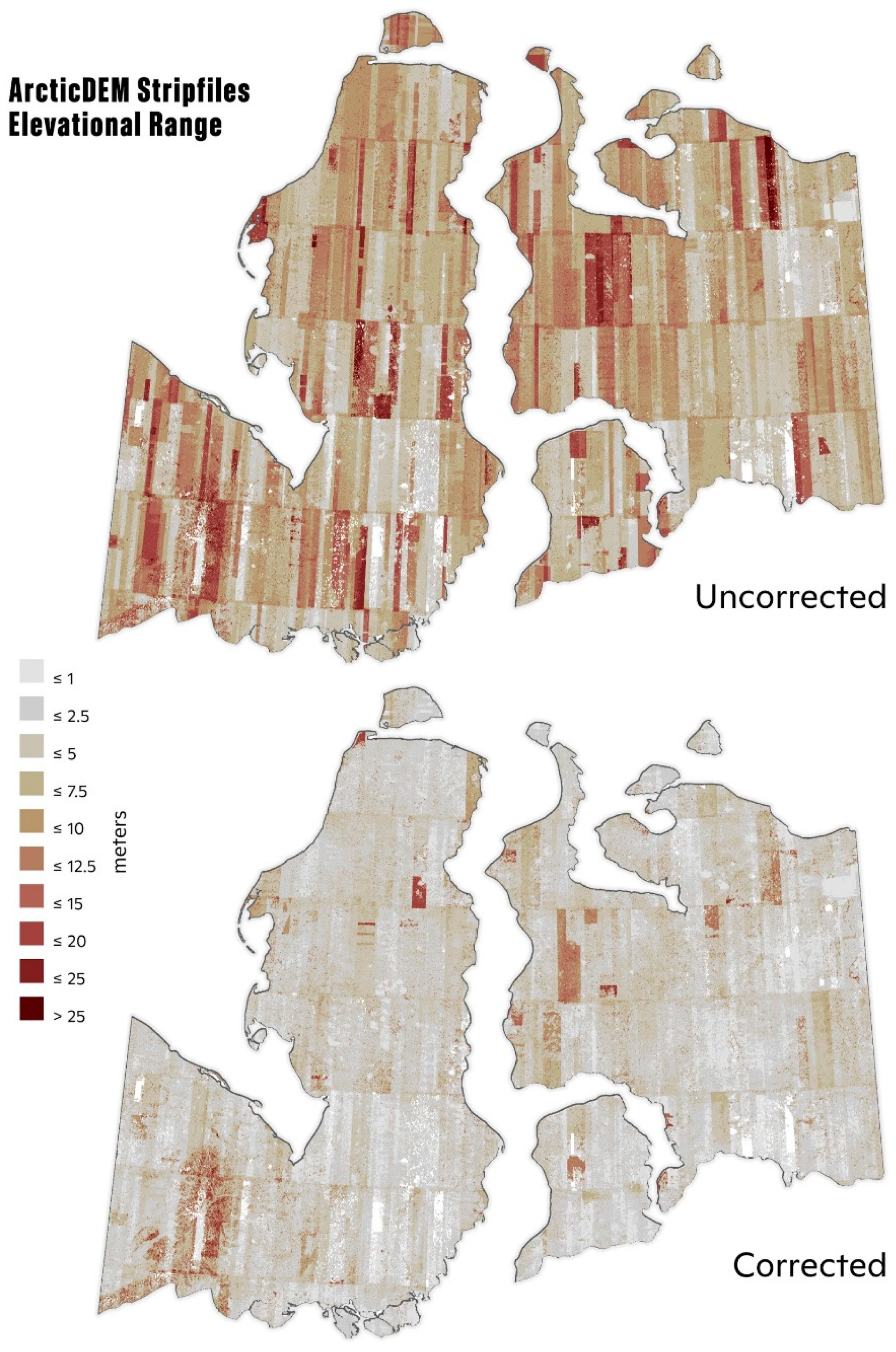
Appendix E
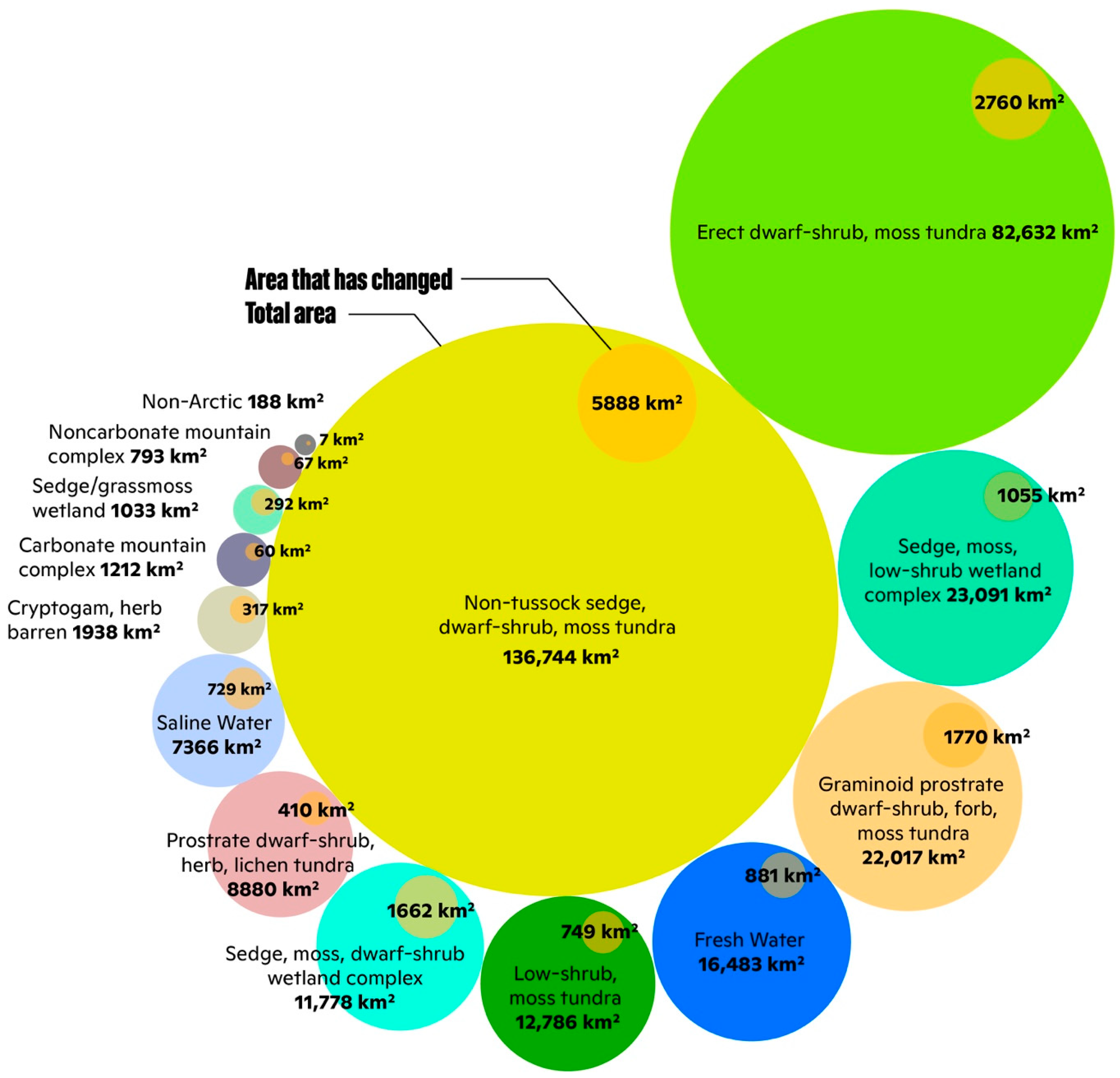
Appendix F
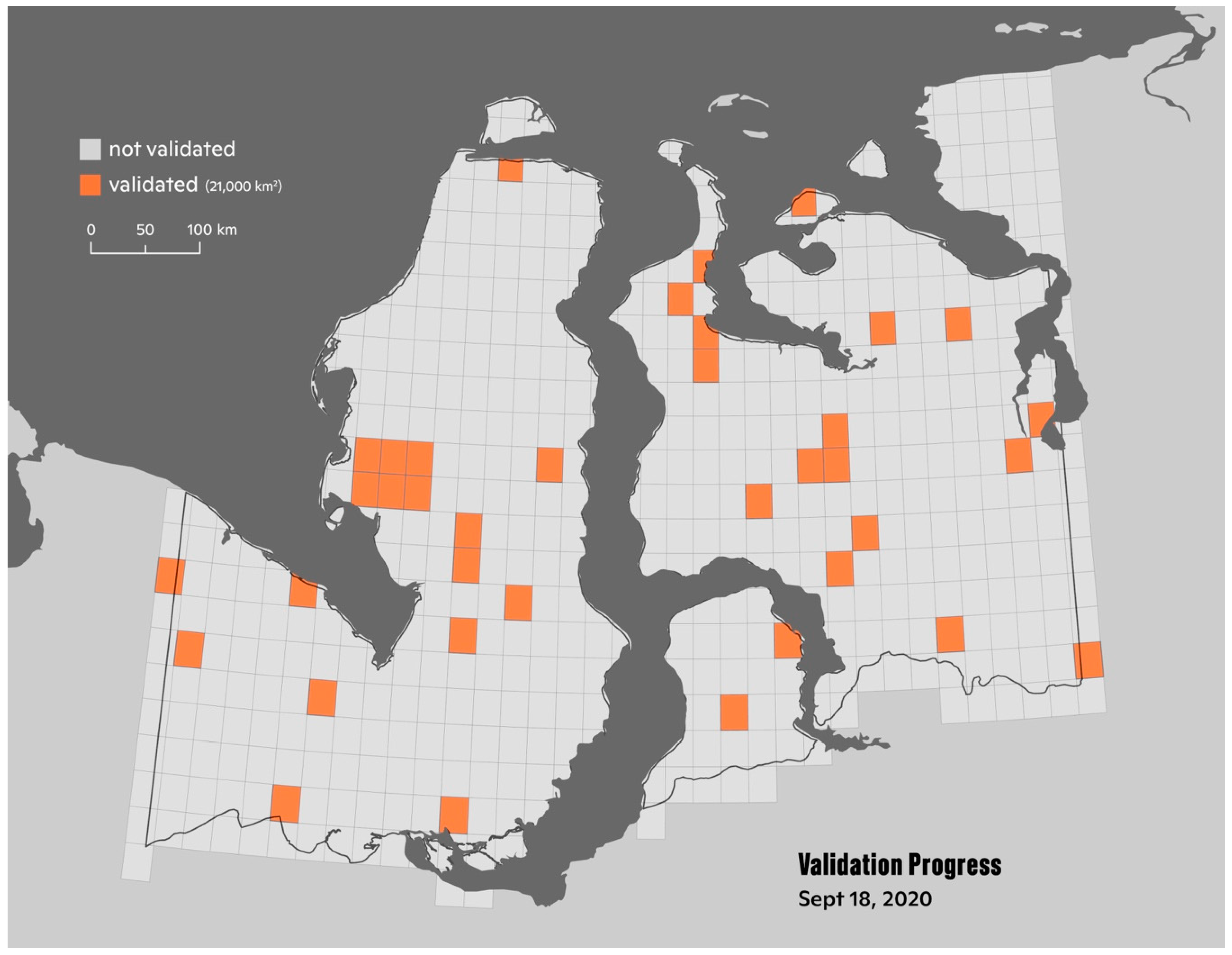
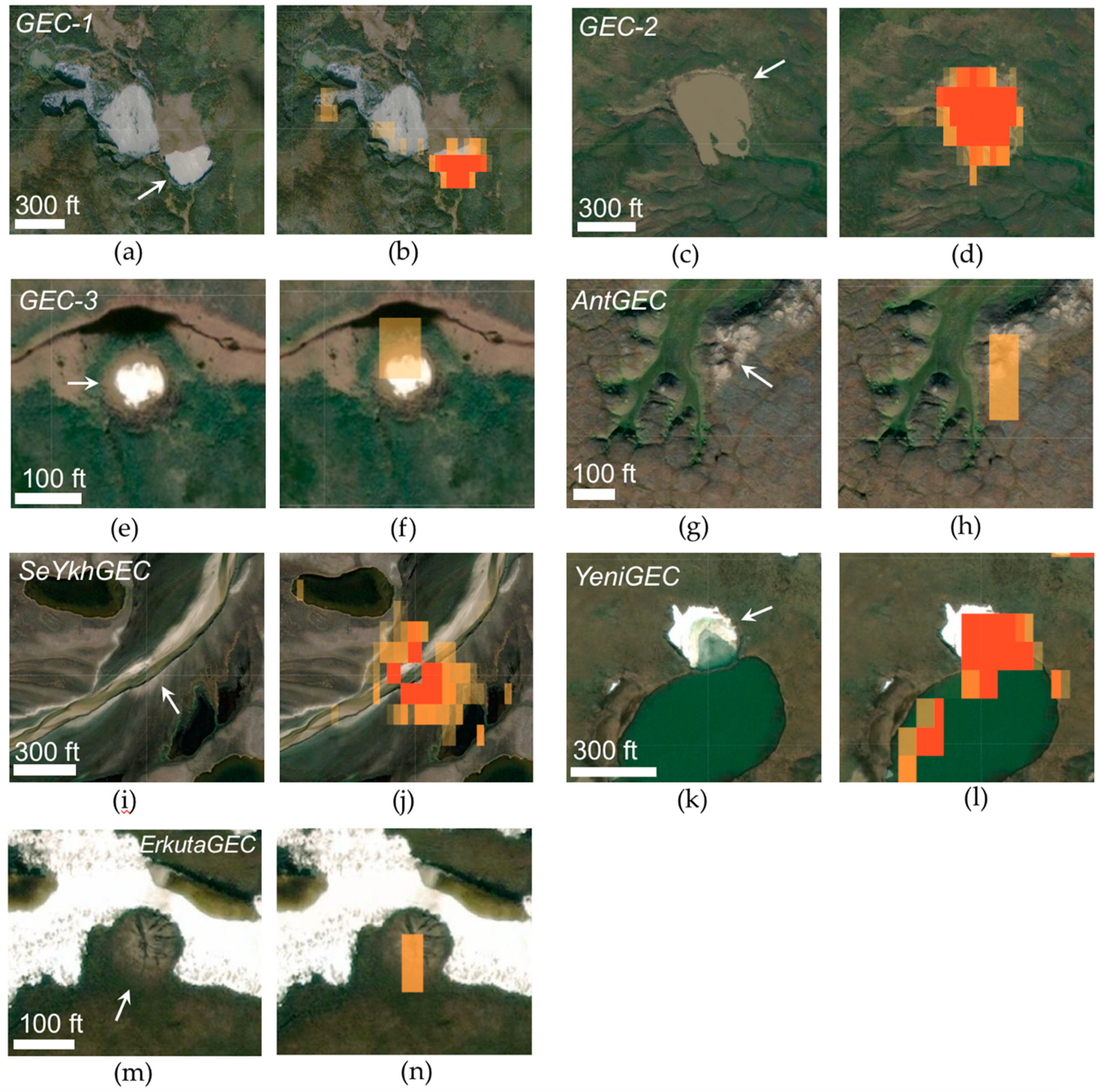
References
- Serreze, M.C.; Barry, R.G. Processes and impacts of Arctic amplification: A research synthesis. Glob. Planet. Change 2011, 77, 85–96. [Google Scholar] [CrossRef]
- Rawlins, M.A.; Steele, M.; Holland, M.M.; Adam, J.C.; Cherry, J.E.; Francis, J.A.; Groisman, P.Y.; Hinzman, L.D.; Huntington, T.G.; Kane, D.L.; et al. Analysis of the Arctic System for Freshwater Cycle Intensification: Observations and Expectations. J. Clim. 2010, 23, 5715–5737. [Google Scholar] [CrossRef]
- Bjorkman, A.D.; Myers-Smith, I.H.; Elmendorf, S.C.; Normand, S.; Rüger, N.; Beck, P.S.A.; Blach-Overgaard, A.; Blok, D.; Cornelissen, J.H.C.; Forbes, B.C.; et al. Plant functional trait change across a warming tundra biome. Nature 2018, 562, 57–62. [Google Scholar] [CrossRef] [PubMed]
- Biskaborn, B.K.; Smith, S.L.; Noetzli, J.; Matthes, H.; Vieira, G.; Streletskiy, D.A.; Schoeneich, P.; Romanovsky, V.E.; Lewkowicz, A.G.; Abramov, A.; et al. Permafrost is warming at a global scale. Nat. Commun. 2019, 10, 1–11. [Google Scholar] [CrossRef] [PubMed]
- Grosse, G.; Jones, B.; Arp, C. Thermokarst Lakes, Drainage, and Drained Basins. In Treatise on Geomorphology; Academic Press: San Diego, CA, USA, 2013; pp. 325–353. ISBN 978-0-08-088522-3. [Google Scholar]
- Schuur, E.A.G.; Mack, M.C. Ecological Response to Permafrost Thaw and Consequences for Local and Global Ecosystem Services. Annu. Rev. Ecol. Evol. Syst. 2018, 49, 279–301. [Google Scholar] [CrossRef]
- Hjort, J.; Karjalainen, O.; Aalto, J.; Westermann, S.; Romanovsky, V.E.; Nelson, F.E.; Etzelmüller, B.; Luoto, M. Degrading permafrost puts Arctic infrastructure at risk by mid-century. Nat. Commun. 2018, 9. [Google Scholar] [CrossRef]
- Van der Sluijs, J.; Kokelj, S.V.; Fraser, R.H.; Tunnicliffe, J.; Lacelle, D. Permafrost Terrain Dynamics and Infrastructure Impacts Revealed by UAV Photogrammetry and Thermal Imaging. Remote Sens. 2018, 10, 1734. [Google Scholar] [CrossRef]
- Rees, W.G.; Williams, M.; Vitebsky, P. Mapping land cover change in a reindeer herding area of the Russian Arctic using Landsat TM and ETM+ imagery and indigenous knowledge. Remote Sens. Environ. 2003, 85, 441–452. [Google Scholar] [CrossRef]
- Fraser, R.H.; Olthof, I.; Carrière, M.; Deschamps, A.; Pouliot, D. Detecting long-term changes to vegetation in northern Canada using the Landsat satellite image archive. Environ. Res. Lett. 2011, 6, 045502. [Google Scholar] [CrossRef]
- Ju, J.; Masek, J.G. The vegetation greenness trend in Canada and US Alaska from 1984–2012 Landsat data. Remote Sens. Environ. 2016, 176, 1–16. [Google Scholar] [CrossRef]
- Pekel, J.-F.; Cottam, A.; Gorelick, N.; Belward, A.S. High-resolution mapping of global surface water and its long-term changes. Nature 2016, 540, 418–422. [Google Scholar] [CrossRef] [PubMed]
- Morin, P.; Porter, C.; Cloutier, M.; Howat, I.; Noh, M.-J.; Willis, M.; Bates, B.; Willamson, C.; Peterman, K. ArcticDEM.; A Publically Available, High Resolution Elevation Model of the Arctic. In Proceedings of the Geophysical Research Abstracts, Vienna, Austria, 17–22 April 2016; Volume 18, p. 1. [Google Scholar]
- Dai, C.; Howat, I.M. Measuring Lava Flows with ArcticDEM: Application to the 2012–2013 Eruption of Tolbachik, Kamchatka. Geophys. Res. Lett. 2017, 44, 12,133–12,140. [Google Scholar] [CrossRef]
- Gorelick, N.; Hancher, M.; Dixon, M.; Ilyushchenko, S.; Thau, D.; Moore, R. Google Earth Engine: Planetary-scale geospatial analysis for everyone. Remote Sens. Environ. 2017, 202, 18–27. [Google Scholar] [CrossRef]
- Kizyakov, A.; Leibman, M.; Zimin, M.; Sonyushkin, A.; Dvornikov, Y.; Khomutov, A.; Dhont, D.; Cauquil, E.; Pushkarev, V.; Stanilovskaya, Y. Gas Emission Craters and Mound-Predecessors in the North of West Siberia, Similarities and Differences. Remote Sens. 2020, 12, 2182. [Google Scholar] [CrossRef]
- Dvornikov, Y.A.; Leibman, M.O.; Khomutov, A.V.; Kizyakov, A.I.; Semenov, P.; Bussmann, I.; Babkin, E.M.; Heim, B.; Portnov, A.; Babkina, E.A.; et al. Gas-emission craters of the Yamal and Gydan peninsulas: A proposed mechanism for lake genesis and development of permafrost landscapes. Permafr. Periglac. Process. 2019, 2014. [Google Scholar] [CrossRef]
- Bogoyavlensky, V.I.; Sizov, O.S.; Nikonov, R.A.; Bogoyavlensky, I.V.; Kargina, T.N. Earth degassing in the Arctic: The genesis of natural and anthropogenic methane emissions. Arct. Ecol. Econ. 2020, 6–22. [Google Scholar] [CrossRef]
- Leibman, M.; Kizyakov, A.; Plekhanov, A.; Streletskaya, I. Russia New Permafrost Feature–Deep Crater in Central Yamal (West Siberia, Russia) as a Response to Local Climate Fluctuations. Geogr. Environ. Sustain. 2014, 7, 68–80. [Google Scholar] [CrossRef]
- Kizyakov, A.; Khomutov, A.; Zimin, M.; Khairullin, R.; Babkina, E.; Dvornikov, Y.; Leibman, M. Microrelief Associated with Gas Emission Craters: Remote-Sensing and Field-Based Study. Remote Sens. 2018, 10, 677. [Google Scholar] [CrossRef]
- Chuvilin, E.; Ekimova, V.; Davletshina, D.; Sokolova, N.; Bukhanov, B. Evidence of Gas Emissions from Permafrost in the Russian Arctic. Geosciences 2020, 10, 383. [Google Scholar] [CrossRef]
- Leibman, M.O. Cryogenic landslides on the Yamal Peninsula, Russia: Preliminary observations. Permafr. Periglac. Process. 1995, 6, 259–264. [Google Scholar] [CrossRef]
- Segal, R.A.; Lantz, T.C.; Kokelj, S.V. Acceleration of thaw slump activity in glaciated landscapes of the Western Canadian Arctic. Environ. Res. Lett. 2016, 11, 034025. [Google Scholar] [CrossRef]
- Bogoyavlensky, V.; Bogoyavlensky, I.; Nikonov, R.; Kishankov, A. Complex of Geophysical Studies of the Seyakha Catastrophic Gas Blowout Crater on the Yamal Peninsula, Russian Arctic. Geosciences 2020, 10, 215. [Google Scholar] [CrossRef]
- Bogoyavlensky, V.I.; Sizov, O.S.; Bogoyavlensky, I.V.; Nikonov, R.A. Remote Site Detection surface gas and gas Arctic Emissions: Yamal Peninsula. Arktika 2016, 3, 4–15. [Google Scholar]
- CAVM Team Circumpolar Arctic Vegetation Map. 2003. Available online: https://www.geobotany.uaf.edu/cavm/ (accessed on 30 December 2020).
- Raynolds, M.K.; Walker, D.A.; Balser, A.; Bay, C.; Campbell, M.; Cherosov, M.M.; Daniëls, F.J.A.; Eidesen, P.B.; Ermokhina, K.A.; Frost, G.V.; et al. A raster version of the Circumpolar Arctic Vegetation Map (CAVM). Remote Sens. Environ. 2019, 232, 111297. [Google Scholar] [CrossRef]
- Brown, J.; Ferrians, O.J., Jr.; Heginbottom, J.A.; Melnikov, E.S. Circum-Arctic Map of Permafrost and Ground-Ice Conditions; USGS: Reston, VA, USA, 1997. [Google Scholar]
- Kizyakov, A.; Zimin, M.; Sonyushkin, A.; Dvornikov, Y.; Khomutov, A.; Leibman, M. Comparison of Gas Emission Crater Geomorphodynamics on Yamal and Gydan Peninsulas (Russia), Based on Repeat Very-High-Resolution Stereopairs. Remote Sens. 2017, 9, 1023. [Google Scholar] [CrossRef]
- Biskaborn, B.K.; Lanckman, J.-P.; Lantuit, H.; Elger, K.; Streletskiy, D.A.; Cable, W.L.; Romanovsky, V.E. The new database of the Global Terrestrial Network for Permafrost (GTN-P). Earth Syst. Sci. Data 2015, 7, 245–259. [Google Scholar] [CrossRef]
- Streletskaya, I.D.; Leibman, M.O. Cryogeochemical Model of Tabular Ground Ice and Cryopegs, Yamal Peninsula, Russia; Swets & Zeitlinger: Lisse, The Netherlands, 2003; pp. 1111–1115. [Google Scholar]
- Buldovicz, S.N.; Khilimonyuk, V.Z.; Bychkov, A.Y.; Ospennikov, E.N.; Vorobyev, S.A.; Gunar, A.Y.; Gorshkov, E.I.; Chuvilin, E.M.; Cherbunina, M.Y.; Kotov, P.I.; et al. Cryovolcanism on the Earth: Origin of a Spectacular Crater in the Yamal Peninsula (Russia). Sci. Rep. 2018, 8, 13534. [Google Scholar] [CrossRef]
- Kizyakov, A.I.; Sonyushkin, A.V.; Leibman, M.O.; Zimin, M.V.; Khomutov, A.V. Geomorphological conditions of the gas-emission crater and its dynamics in Central Yamal. Earth’s Cryosphere 2015, 14, 13–22. [Google Scholar]
- Savvichev, A.; Leibman, M.; Kadnikov, V.; Kallistova, A.; Pimenov, N.; Ravin, N.; Dvornikov, Y.; Khomutov, A. Microbiological Study of Yamal Lakes: A Key to Understanding the Evolution of Gas Emission Craters. Geosciences 2018, 8, 478. [Google Scholar] [CrossRef]
- Vorobyev, S.; Bychkov, A.; Khilimonyuk, V.; Buldovicz, S.; Ospennikov, E.; Chuvilin, E. Formation of the Yamal Crater in Northern West Siberia: Evidence from Geochemistry. Geosciences 2019, 9, 515. [Google Scholar] [CrossRef]
- Chuvilin, E.; Sokolova, N.; Davletshina, D.; Bukhanov, B.; Stanilovskaya, J.; Badetz, C.; Spasennykh, M. Conceptual Models of Gas Accumulation in the Shallow Permafrost of Northern West Siberia and Conditions for Explosive Gas Emissions. Geosciences 2020, 10, 195. [Google Scholar] [CrossRef]
- Ulmishek, G.F. Petroleum Geology and Resources of the West Siberian Basin, Russia; U.S. Geological Survey: Reston, Virginia, USA, 2003. [Google Scholar]
- Forbes, B.C.; Stammler, F.; Kumpula, T.; Meschtyb, N.; Pajunen, A.; Kaarlejärvi, E. High resilience in the Yamal-Nenets social–ecological system, west Siberian Arctic, Russia. Proc. Natl. Acad. Sci. USA 2009, 106, 22041–22048. [Google Scholar] [CrossRef]
- Kumpula, T.; Forbes, B.C.; Stammler, F. Remote Sensing and Local Knowledge of Hydrocarbon Exploitation: The Case of Bovanenkovo, Yamal Peninsula, West Siberia, Russia. Arctic 2010, 63, 165–178. [Google Scholar] [CrossRef]
- World Meteorological Organization Climate Explorer. Available online: https://climexp.knmi.nl/start.cgi (accessed on 25 October 2020).
- Kennedy, R.E.; Yang, Z.; Cohen, W.B. Detecting trends in forest disturbance and recovery using yearly Landsat time series: 1. LandTrendr—Temporal segmentation algorithms. Remote Sens. Environ. 2010, 114, 2897–2910. [Google Scholar] [CrossRef]
- Guay, K.C.; Beck, P.S.A.; Berner, L.T.; Goetz, S.J.; Baccini, A.; Buermann, W. Vegetation productivity patterns at high northern latitudes: A multi-sensor satellite data assessment. Glob. Change Biol. 2014, 20, 3147–3158. [Google Scholar] [CrossRef] [PubMed]
- Kennedy, R.; Yang, Z.; Gorelick, N.; Braaten, J.; Cavalcante, L.; Cohen, W.; Healey, S. Implementation of the LandTrendr Algorithm on Google Earth Engine. Remote Sens. 2018, 10, 691. [Google Scholar] [CrossRef]
- Foga, S.; Scaramuzza, P.L.; Guo, S.; Zhu, Z.; Dilley, R.D.; Beckmann, T.; Schmidt, G.L.; Dwyer, J.L.; Joseph Hughes, M.; Laue, B. Cloud detection algorithm comparison and validation for operational Landsat data products. Remote Sens. Environ. 2017, 194, 379–390. [Google Scholar] [CrossRef]
- Landis, J.R.; Koch, G.G. The Measurement of Observer Agreement for Categorical Data. Biometrics 1977, 33, 159. [Google Scholar] [CrossRef]
- R Core Team. R Core Team 2019; R Foundation for Statistical Computing: Vienna, Austria, 2019. [Google Scholar]
- Bronaugh, D.; Werner, A. zyp: Zhang + Yue-Pilon Trends Package; Pacific Climate Impacts Consortium: Victoria, BC, Canada, 2013. [Google Scholar]
- Yue, S.; Pilon, P.; Phinney, B.; Cavadias, G. The influence of autocorrelation on the ability to detect trend in hydrological series. Hydrol. Process. 2002, 16, 1807–1829. [Google Scholar] [CrossRef]
- Lantuit, H.; Overduin, P.P.; Couture, N.; Wetterich, S.; Aré, F.; Atkinson, D.; Brown, J.; Cherkashov, G.; Drozdov, D.; Forbes, D.L.; et al. The Arctic Coastal Dynamics Database: A New Classification Scheme and Statistics on Arctic Permafrost Coastlines. Estuaries Coast. 2012, 35, 383–400. [Google Scholar] [CrossRef]
- French, H.M. The Periglacial Environment, 4th ed.; Wiley-Blackwell: Hoboken, NJ, USA, 2018; ISBN 978-1-119-13281-3. [Google Scholar]
- Mackay, J.R. The Growth of Pingos, Western Arctic Coast, Canada. Can. J. Earth Sci. 1973, 10, 979–1004. [Google Scholar] [CrossRef]
- Samsonov, S.V.; Lantz, T.C.; Kokelj, S.V.; Zhang, Y. Growth of a young pingo in the Canadian Arctic observed by RADARSAT-2 interferometric satellite radar. Cryosphere 2016, 10, 799–810. [Google Scholar] [CrossRef]
- Mackay, J.R. Aklisuktuk (Growing Fast) Pingo, Tuktoyaktuk Peninsula, Northwest Territories, Canada. Arctic 1981, 34, 270–273. [Google Scholar] [CrossRef]
- Mackay, J.R. Pingo collapse and paleoclimatic reconstruction. Can. J. Earth Sci. 1988, 25, 495–511. [Google Scholar] [CrossRef]
- Chuvilin, E.; Stanilovskaya, J.; Titovsky, A.; Sinitsky, A.; Sokolova, N.; Bukhanov, B.; Spasennykh, M.; Cheremisin, A.; Grebenkin, S.; Davletshina, D.; et al. A Gas-Emission Crater in the Erkuta River Valley, Yamal Peninsula: Characteristics and Potential Formation Model. Geosciences 2020, 10, 170. [Google Scholar] [CrossRef]
- Mackay, J.R. Pingos of the Tuktoyaktuk Peninsula Area, Northwest Territories. Géographie Phys. Quat. 1979, 33, 3–61. [Google Scholar] [CrossRef]
- Brooker, A.; Fraser, R.H.; Olthof, I.; Kokelj, S.V.; Lacelle, D. Mapping the Activity and Evolution of Retrogressive Thaw Slumps by Tasselled Cap Trend Analysis of a Landsat Satellite Image Stack. Permafr. Periglac. Process. 2014, 25, 243–256. [Google Scholar] [CrossRef]
- Fritz, M.; Vonk, J.E.; Lantuit, H. Collapsing Arctic coastlines. Nat. Clim. Change 2017, 7, 6–7. [Google Scholar] [CrossRef]
- Jones, B.M.; Grosse, G.; Arp, C.D.; Jones, M.C.; Walter Anthony, K.M.; Romanovsky, V.E. Modern thermokarst lake dynamics in the continuous permafrost zone, northern Seward Peninsula, Alaska. J. Geophys. Res. 2011, 116, G00M03. [Google Scholar] [CrossRef]
- Kokelj, S.V.; Lantz, T.C.; Tunnicliffe, J.; Segal, R.; Lacelle, D. Climate-driven thaw of permafrost preserved glacial landscapes, northwestern Canada. Geology 2017, 45, 371–374. [Google Scholar] [CrossRef]
- Liljedahl, A.K.; Boike, J.; Daanen, R.P.; Fedorov, A.N.; Frost, G.V.; Grosse, G.; Hinzman, L.D.; Iijma, Y.; Jorgenson, J.C.; Matveyeva, N.; et al. Pan-Arctic ice-wedge degradation in warming permafrost and its influence on tundra hydrology. Nat. Geosci. 2016, 9, 312–318. [Google Scholar] [CrossRef]
- Myers-Smith, I.H.; Kerby, J.T.; Phoenix, G.K.; Bjerke, J.W.; Epstein, H.E.; Assmann, J.J.; John, C.; Andreu-Hayles, L.; Angers-Blondin, S.; Beck, P.S.A.; et al. Complexity revealed in the greening of the Arctic. Nat. Clim. Change 2020, 10, 106–117. [Google Scholar] [CrossRef]
- Zwieback, S.; Kokelj, S.V.; Günther, F.; Boike, J.; Grosse, G.; Hajnsek, I. Sub-seasonal thaw slump mass wasting is not consistently energy limited at the landscape scale. Cryosphere 2018, 12, 549–564. [Google Scholar] [CrossRef]
- Teshebaeva, K.; van Huissteden, K.J.; Puzanov, A.V.; Balykin, D.N.; Sinitsky, A.I.; Kovalevskaya, N. Permafrost seasonal surface changes revealed from Sentinel-1 InSAR time-series, Yamal peninsula. Proc. Int. Assoc. Hydrol. Sci. 2020, 382, 183–187. [Google Scholar] [CrossRef]
- Huang, L.; Liu, L.; Jiang, L.; Zhang, T. Automatic Mapping of Thermokarst Landforms from Remote Sensing Images Using Deep Learning: A Case Study in the Northeastern Tibetan Plateau. Remote Sens. 2018, 10, 2067. [Google Scholar] [CrossRef]
- Lewkowicz, A.G.; Way, R.G. Extremes of summer climate trigger thousands of thermokarst landslides in a High Arctic environment. Nat. Commun. 2019, 10. [Google Scholar] [CrossRef]
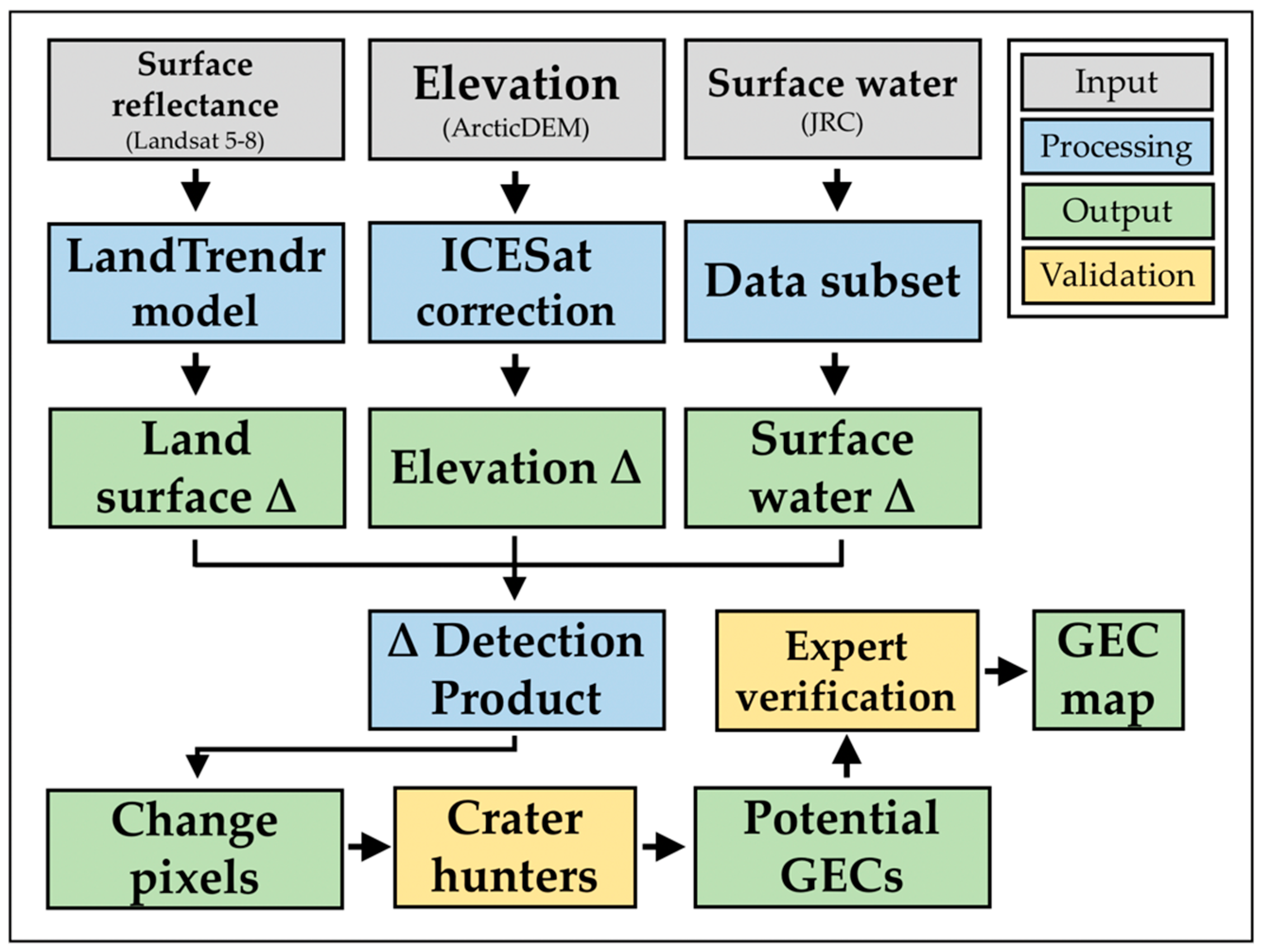
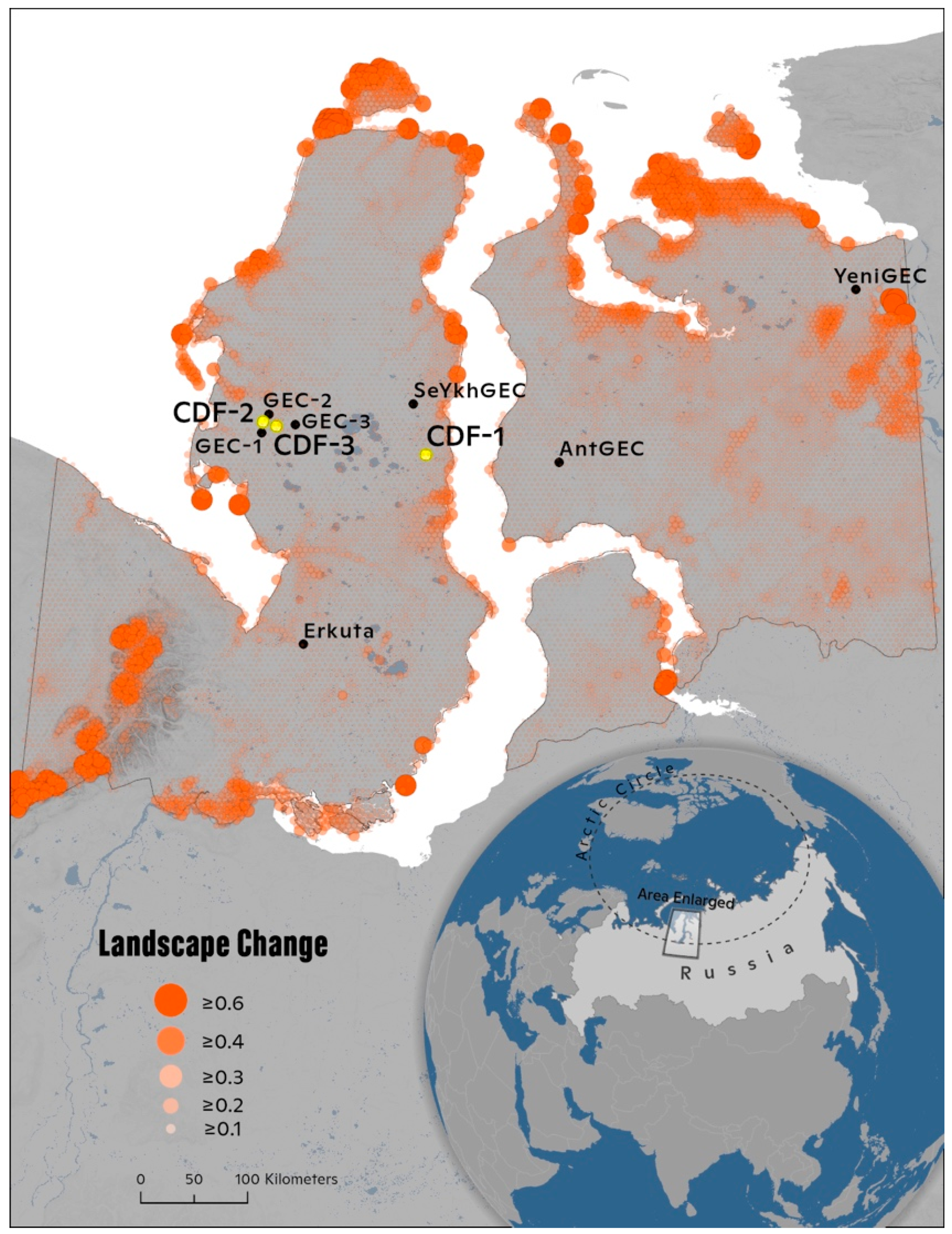
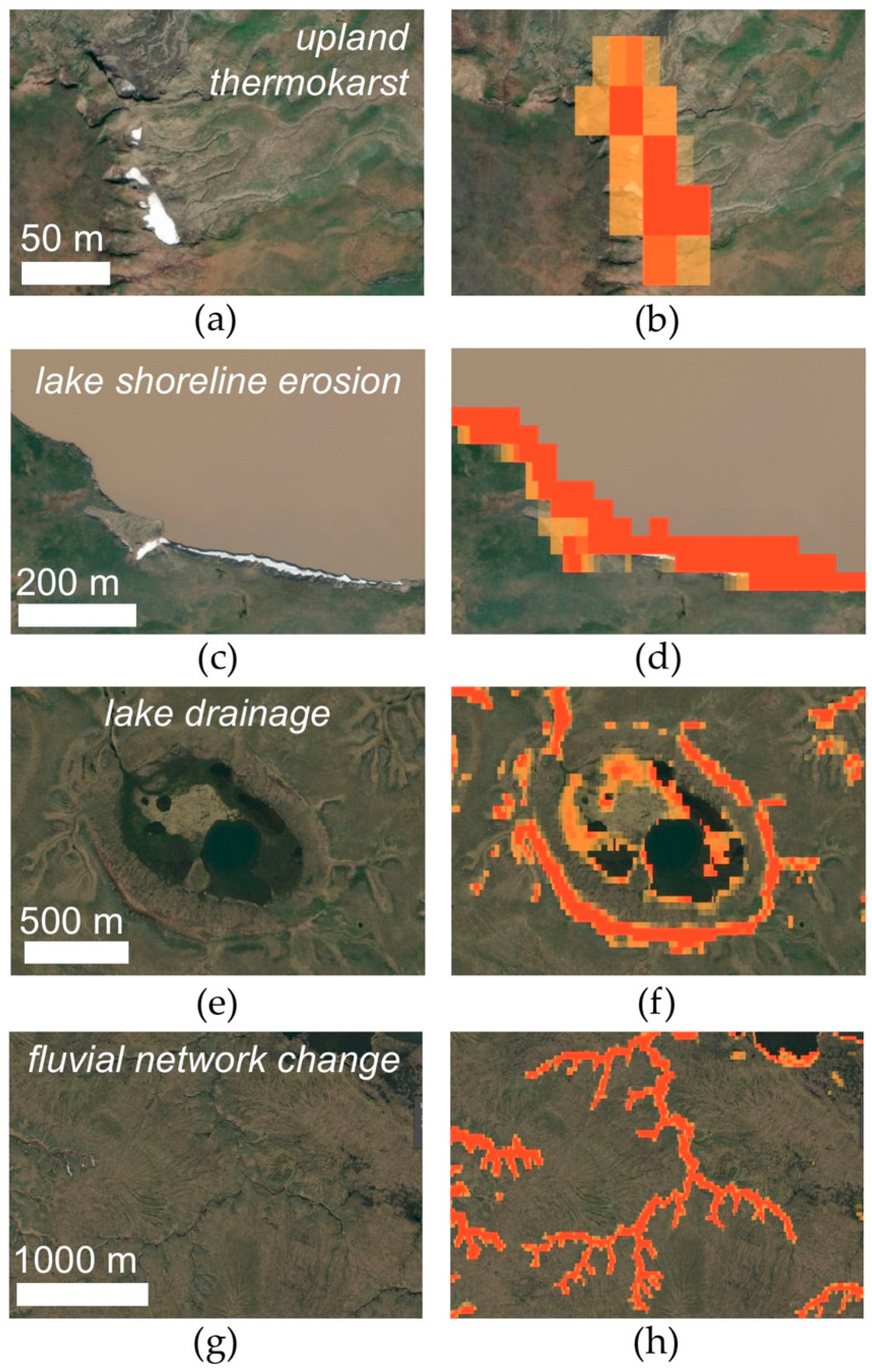
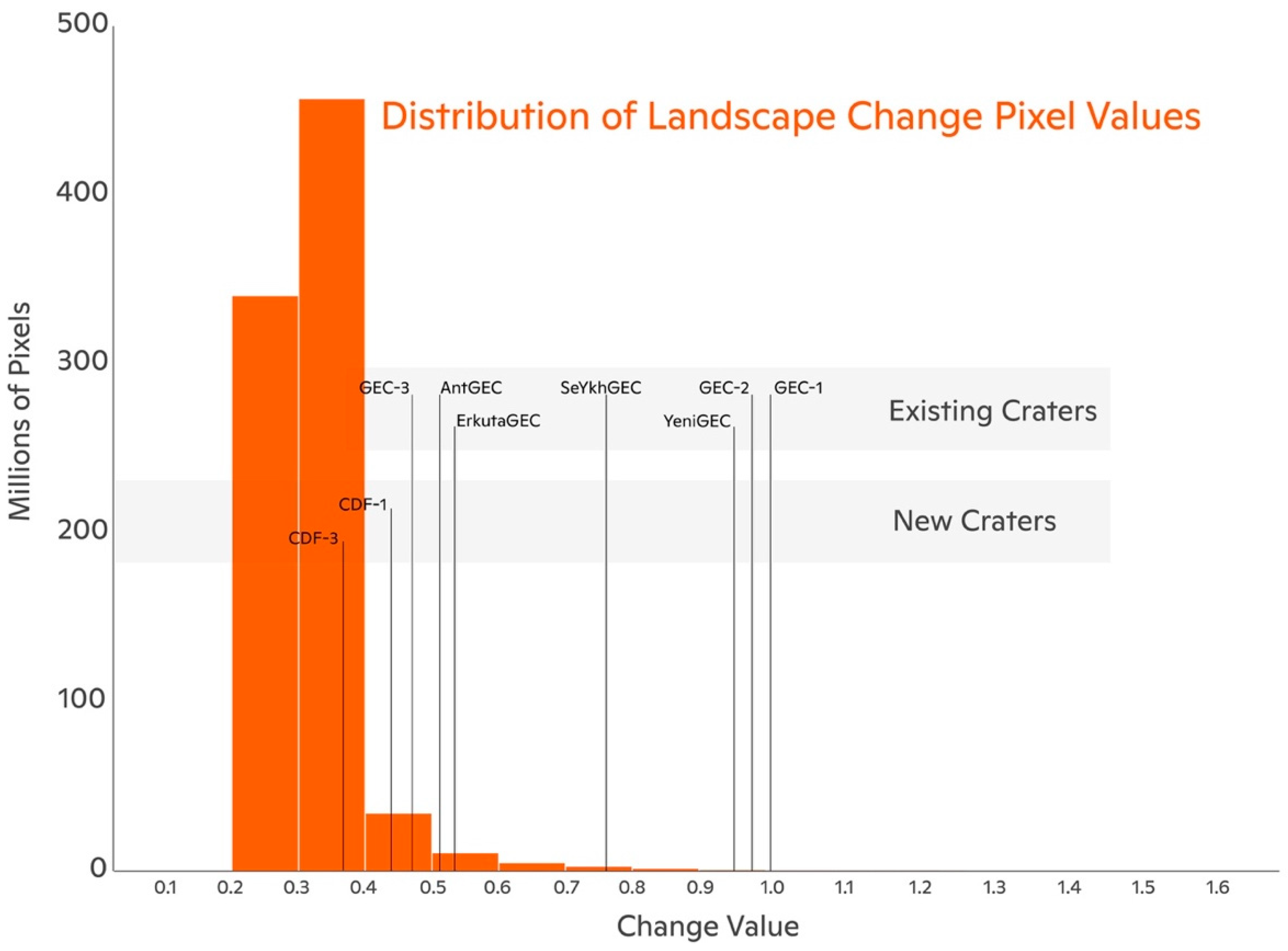
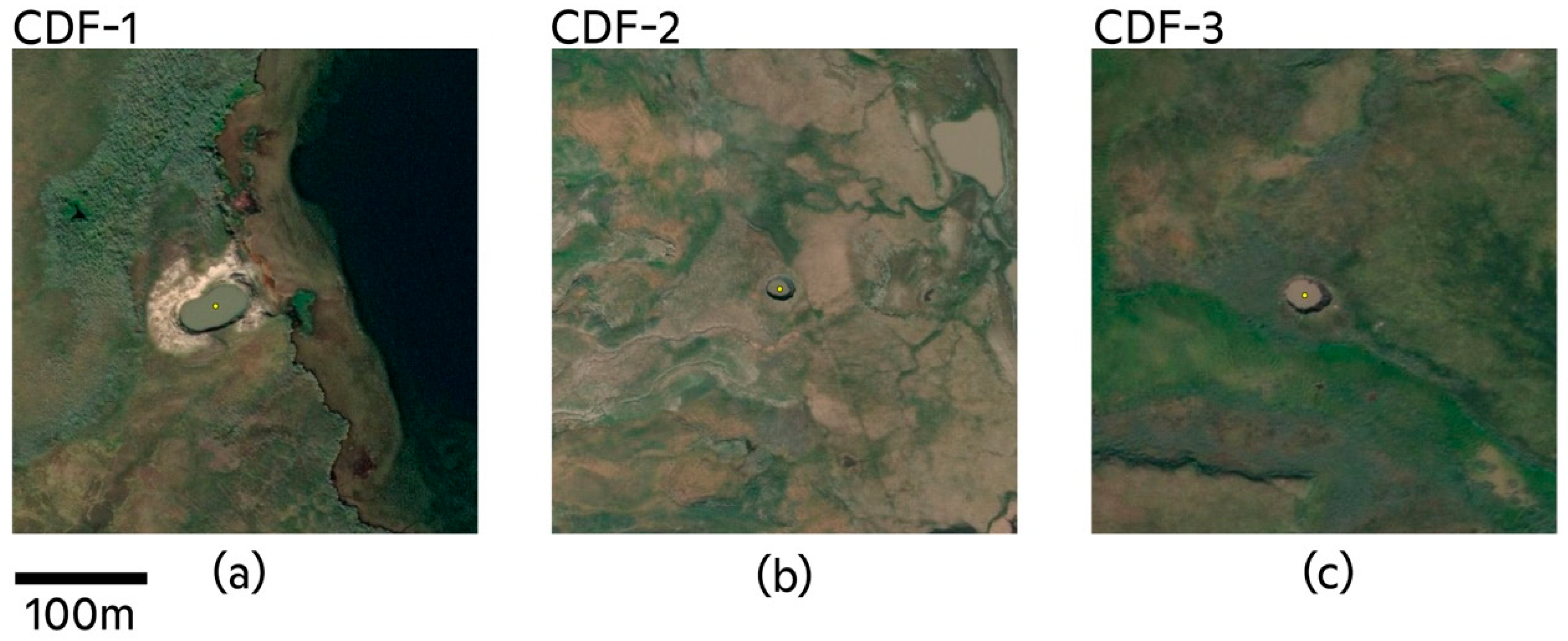
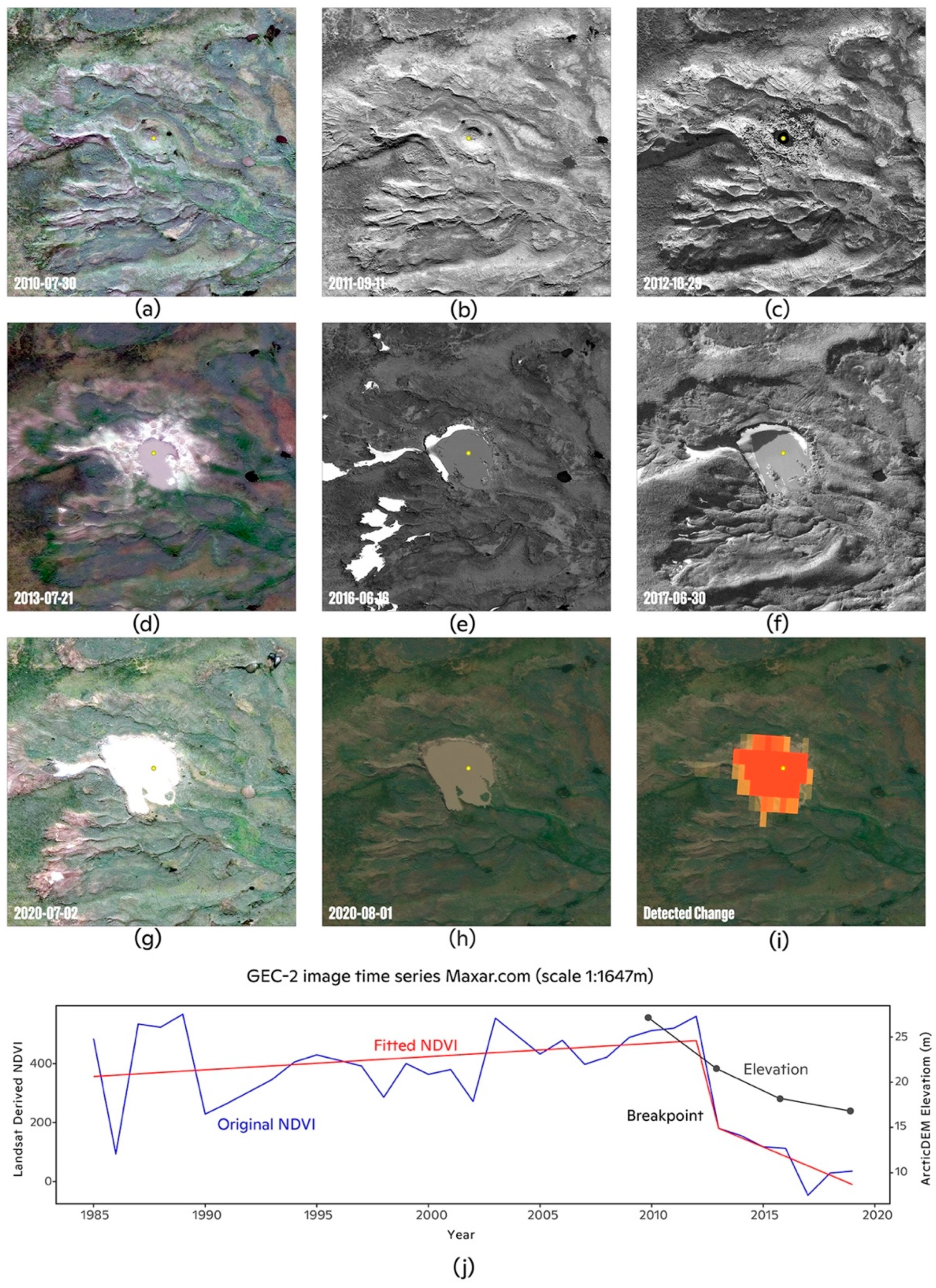
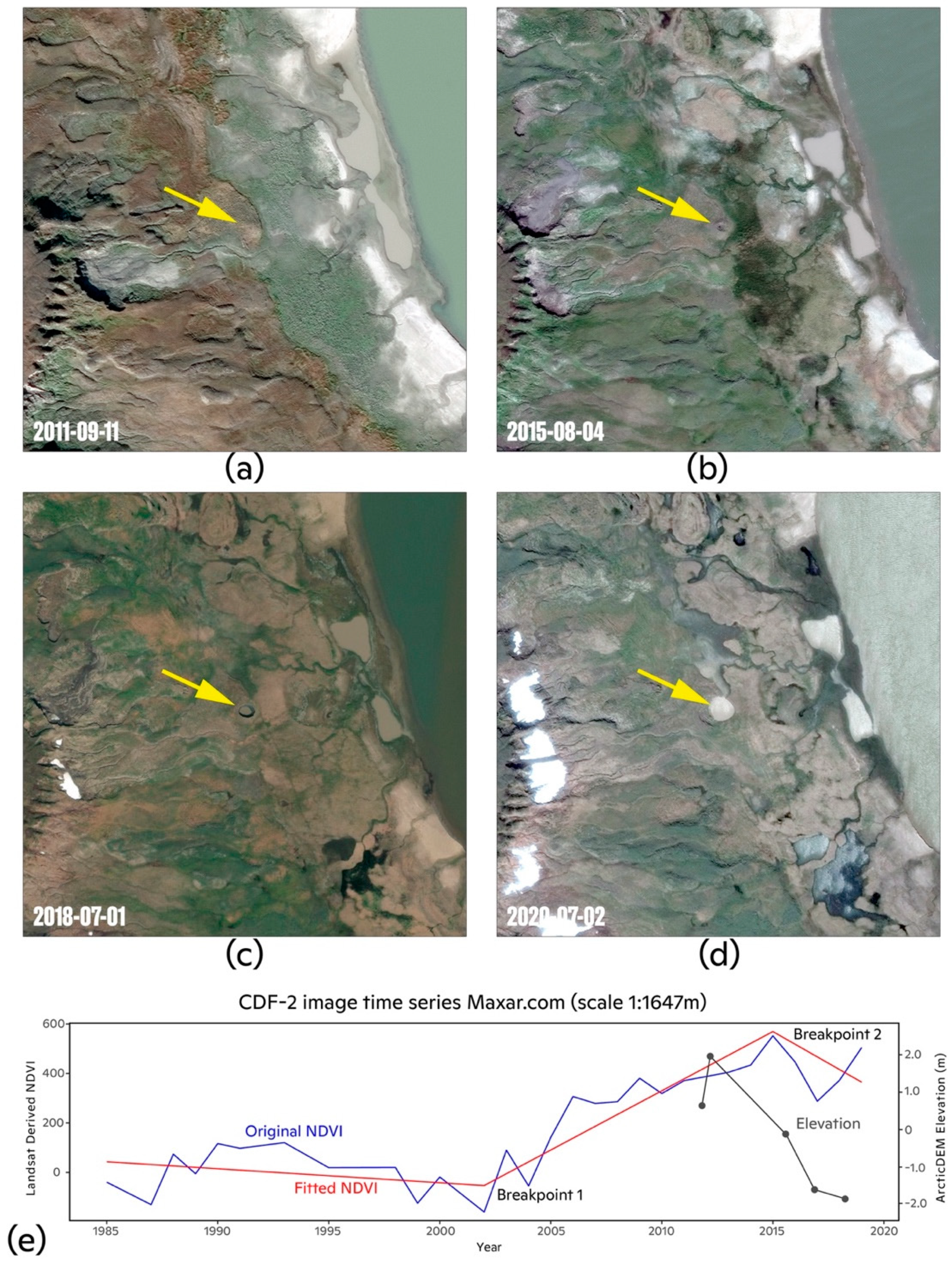
| CAVM Category (Generalized) | n CAVM Categories Represented | Total (km2) | Total Area (%) | Total Change (km2) | Change Proportion |
|---|---|---|---|---|---|
| Upland/non-wetland tundra | 5 | 263,059 | 80.5 | 11,577 | 0.04 |
| Wetland complex | 3 | 35,902 | 11.0 | 3009 | 0.08 |
| Water | 2 | 23,849 | 7.3 | 1610 | 0.07 |
| Mountains/barren terrain | 3 | 3943 | 1.2 | 444 | 0.11 |
| Crater | Alternate GEC IDs | Lat (DD) | Long (DD) | Date Formed | Diameter (m) | Depth (m) | CDA (∆) 5 |
|---|---|---|---|---|---|---|---|
| GEC-1 | C1 1 | 69.9711 | 68.3703 | October 2013–April 2014 3 | 25–29 4 | 50–70 3 | 1.00 |
| GEC-2 | C2 1 | 70.1446 | 68.4959 | September–October 2012 4 | 32–35 4 | - | 0.97 |
| GEC-3 | C9 2 | 70.0625 | 69.0995 | October 2012–June 2013 4 | 35–37 4 | - | 0.48 |
| AntGEC | C3 2 | 69.7946 | 75.0350 | September 2013 3 | 25–28 3 | 15–19 3 | 0.52 |
| SeYkhGEC | C11 1 | 70.3020 | 71.7455 | June 2017 4 | 76–88 4 | 56 1 | 0.78 |
| YeniGEC | C4 2 | 71.2859 | 81.9250 | - | - | - | 0.95 |
| ErkutaGEC | C12 2 | 68.1107 | 69.5521 | 2016–2017 | 10–12 | 20 | 0.54 |
| CDF-1 | - | 69.8434 | 72.0637 | - | 18–30 5 | - | 0.44 |
| CDF-2 | - | 70.0679 | 68.3769 | 2015 5 | 12–15 5 | - | * |
| CDF-3 | - | 70.0388 | 68.6897 | 2011–2015 5 | 20–22 5 | - | 0.38 |
Publisher’s Note: MDPI stays neutral with regard to jurisdictional claims in published maps and institutional affiliations. |
© 2021 by the authors. Licensee MDPI, Basel, Switzerland. This article is an open access article distributed under the terms and conditions of the Creative Commons Attribution (CC BY) license (http://creativecommons.org/licenses/by/4.0/).
Share and Cite
Zolkos, S.; Fiske, G.; Windholz, T.; Duran, G.; Yang, Z.; Olenchenko, V.; Faguet, A.; Natali, S.M. Detecting and Mapping Gas Emission Craters on the Yamal and Gydan Peninsulas, Western Siberia. Geosciences 2021, 11, 21. https://doi.org/10.3390/geosciences11010021
Zolkos S, Fiske G, Windholz T, Duran G, Yang Z, Olenchenko V, Faguet A, Natali SM. Detecting and Mapping Gas Emission Craters on the Yamal and Gydan Peninsulas, Western Siberia. Geosciences. 2021; 11(1):21. https://doi.org/10.3390/geosciences11010021
Chicago/Turabian StyleZolkos, Scott, Greg Fiske, Tiffany Windholz, Gabriel Duran, Zhiqiang Yang, Vladimir Olenchenko, Alexey Faguet, and Susan M. Natali. 2021. "Detecting and Mapping Gas Emission Craters on the Yamal and Gydan Peninsulas, Western Siberia" Geosciences 11, no. 1: 21. https://doi.org/10.3390/geosciences11010021
APA StyleZolkos, S., Fiske, G., Windholz, T., Duran, G., Yang, Z., Olenchenko, V., Faguet, A., & Natali, S. M. (2021). Detecting and Mapping Gas Emission Craters on the Yamal and Gydan Peninsulas, Western Siberia. Geosciences, 11(1), 21. https://doi.org/10.3390/geosciences11010021






